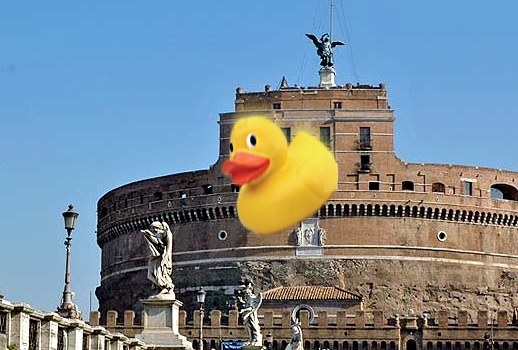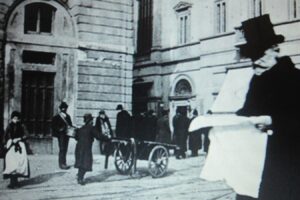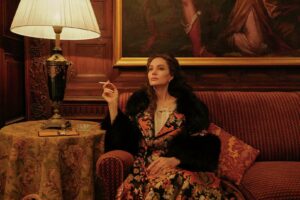

The implication here is that the director doesn’t understand the plot or the time frame of Tosca, when in fact it seems that Luc Bondy understands it better than most. “Traditionally,” at least in the Franco Zeffirelli production of this opera, the diva appears on the rampart of the Castel Sant’Angelo in the same ballgown she wore to the gala at the Palazzo Farnese, accessorized with a distinctly out-of-season dark wool cape. But according to the libretto, Tosca indeed has had at least a few hours’ time to change her dress, and there is a very strong implication that she has not come directly to Sant’Angelo from the Palazzo Farnese. In the third act, she sings
Senti… l’ora è vicina; io già raccolsi
(mostrando la borsa)
oro e gioielli… una vettura è pronta.
So Tosca has “gathered gold and jewels” and hired a carriage (“vettura” implies a hackney) in preparation for the planned flight from Rome. Presumably she does not attend command performances for the Queen carrying all her money and gold with her, so she would have had to “gather” these items from where she was living. Assuming she is at all thinking clearly (admittedly a big “if” for an opera diva) she would logically have changed into some sort of outfit practical for traveling. The port of Civitavecchia is about 40 miles from the Castel Sant’Angelo, which would be a journey of about four hours—which would be followed, of course, by a day or more of travel in a sailboat (“tartana”).
Now, where would Tosca gather these things? We are not told where she is living in Rome, but the Sardou play establishes that she is singing at the Teatro Argentina so it is not illogical to think that she may be renting a flat or a house in the neighborhood of that theater—which, as it happens, is only a few blocks from the Palazzo Farnese. (It is less likely that she would have had time to retrieve anything from Cavaradossi’s villa, which Sardou places “between the Baths of
Caracalla and the mausoleum of the Scipions,” and therefore considerably to the south and east of the city center.)
Let’s remember, too, that Tosca is an opera singer. She tours. So she likely owns outfits that are designed specifically for travel. At the very least she has daytime street dresses, and it is certainly not implausible to think that she would stop and consider how odd and suspicious it would look for a celebrated opera diva to saunter onto the docks at Civitavecchi in broad daylight decked out in a blood-stained evening gown.
Now, this doesn’t mean Tosca must change dresses, though to my mind changing dresses makes more sense dramatically. But she definitely does have both the time and the motivation to change into “a nice little black number” or something similarly understated for her planned hasty journey.
It should be pointed out that this argument applies only to the opera of Tosca, not the original Sardou play. In the drama the scenes are arranged somewhat differently. Scarpia’s office is actually in the Castel Sant’Angelo, and he keeps Tosca waiting in an anteroom there most of the night, until just before the scheduled time for Cavaradossi’s execution at dawn. The fourth act ends with the murder and the fifth begins almost immediately afterward, with Tosca arriving at Cavaradossi’s cell. She has not left the Castel Sant’Angelo and naturally would not have had time to change clothes.

























Comments